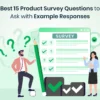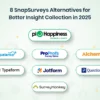With businesses today totally dependent on visitors, customer feedback has become the topmost priority to know about the performance of the business. Customer feedback plays a key role in making the product the best. It helps keep users engaged and helps you to build a better product.
However, collecting and managing feedback using customer feedback software today is treated as a reconsideration. An irregular NPS survey is sent out to a few users, and their responses are noted down in an excel sheet and the sheet is never looked upon again. This is how many companies have handled customer feedback for a too long time. However, this is an incredibly inefficient and unproductive approach.
Unlock the power of customer feedback with piHappiness!❤️
Boost your business insights and drive growth today—start gathering valuable feedback now!
If you really want to grow and improve your business and retain your existing customers, then you will have to know what your customer thinks about your business (products or services). For this, you need your customer’s feedback and a strategic system for managing and analyzing it.
If said honestly, as a matter of fact, that is much not exactly simple or easy. Redesigning the manner in which your organization has consistently gathered client criticism and executing an entirely different system to gather, analyze, learn, act, and follow-up feedback will take time and persistence, yet having a smoothed-out process and having the option to all the more likely comprehend and follow up on your clients’ necessities will be definitely justified. Let’s go to more in detail.
What Customer Feedback is All About?
Customer Feedback is nothing, but simple information provided by customers about their experience with a product or service. The main purpose is to reveal their level of satisfaction and help the product, client achievement, and marketing teams comprehend where there is an opportunity to get better.
Organizations can collect customer feedback proactively by polling and surveying customers with a good customer feedback tool, by taking their interviews, or by asking for their reviews.
Teams can likewise gather feedback by giving clients a spot in the product where they can share remarks, grievances, or praises.
Further, there are usability tests, in-app surveys, emails or phone calls, comment cards, focus group discussions, online reviews, and customer interviews, through which customer feedback can be gathered.
Finally, customer feedback can come in many different forms, but it is essentially any information that a user provides you with about their experience with your product.
Why is Customer Feedback Important?
According to HubSpot CEO, Brian Halligan, “If we don’t know what is right, we can’t accomplish a greater amount of it. In the event that we don’t have the foggiest idea what’s going on, we can’t do less of it.”
Without client feedback, we won’t be able to succeed, we may fail. And therefore, it is important to collect customer feedback. Collecting customer feedback helps improve your product by providing data to help you make better-informed business decisions and show customers that you value their opinions.
According to some studies, it has been seen that highly engaged customers buy 90% more often and spend 60% more per transaction.
By measuring customer satisfaction and by listening to what customers are saying about your products and services, you can create the best customer experience possible and strengthen your relationships with your customers. This will lead to improved retention rates, upsell revenue, and referrals.
Collecting and managing customer feedback properly is the best way to make sure that your customers feel valued and ensure that you are building the features that your customers will actually use.
Product Feedback Collection and Their Various Types
A product review is exactly what it sounds like; any comments from your users about your products. How it functions, that it is so natural to utilize, and how happy they are with the experience.
Typically, when you’re collecting customer feedback on your product, you’re looking for their opinion on a new feature you’ve recently added, an update to your product, or your roadmap.
Product feedback can be divided into two categories: proactive feedback and reactive feedback. Proactive feedback is information that has been actively gathered from your users, like sending out a survey. Whereas Reactive feedback is any information that a user sends of their own volition, such as submitting a feature request or bug report.
Some of the common ways users are asked for product feedback include in-app surveys, feature requests, NPS, CSAT, and CES. Let’s break down each of them.
In-App Surveys
In-app surveys are one of the simplest and fastest ways to collect feedback from your users. If a user has just finished using a feature, then send him/her a survey directly within your product, asking him/her what they think about it. As the experience will be different for them, they would be able to give reliable data.
Net Promoter Score (NPS)
We have all seen the working of the NPS system, and it is regularly used to measure your clients’ general impression of your organization.
Although we think NPS can be helpful in certain circumstances, in reality, it is not the most effective way to quantify the progress of a product. It is not particularly actionable and can be impacted by many factors other than the product itself.
If you wish to use NPS to measure your product’s success, we recommend you use an actual Net Promoter Score. By using the actual NPS, you can get the actual, hard data from your users about your product.
Customer Effort Score (CES)
The main aim of the CES score is to measure the effort required to achieve an intended outcome with your product or service. Although it has been designed to collect feedback about service-oriented companies, it can be important for software associations, since client maintenance is intently attached to client reliability.
CES permits organizations to recognize the pain points their users experience with their products so they can add something to their roadmap to make the user experience smoother.
Customer Satisfaction Score (CSAT)
We have all come across customer satisfaction surveys; they actually show a user’s overall content or discontent with the product. Users are asked to rank a product on a scale of 1-5 or 1-10 and then we take the sum of the scores and divide it by the number of respondents.
In general, CSAT is used by customer and support teams, and it measures a user’s satisfaction with your product or a certain feature of your product. And that’s why this metric works well in evaluating the success of creating a new feature or updating an aspect of your product.
Feature Requests
Permitting your users to submit feature requests is a great way to ensure responsive feedback. Strategic requests from your users can be used to understand your users’ needs and your roadmap.
If there are certain things that you receive repeatedly from many different users, that can be a clear sign that it is something that you should consider including in your product roadmap.
How to Improve Customer Feedback Strategy?
Do Everything on Time: Emailing a survey to your customers would be like asking for more than they will give, particularly, on the grounds that perusing the mail pulls them out of the product.
Instead, you can survey them in-app so that they receive the question while using the product. In-app surveys can provide more accurate feedback and have higher response rates.
Make the Feedback Mechanism Simple: Collecting feedback should be on a customer-oriented, not a company-oriented basis. This means that customers should not put too much effort into the product to give feedback, if that happens, it will not be easy for them to give feedback.
An occasional survey is sometimes not enough. Only an effective program can make the feedback process as easy as possible and reach every customer at any time.
Close The Loop: Often, companies collect feedback using a customer feedback app, but it ends up in a black hole, never to be integrated or acted upon. Ensure that the company has a clear vision and process before collecting feedback, as well as tools to collect, prioritize and manage feedback.








